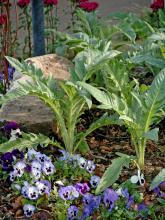Information Possibly Outdated
The information presented on this page was originally released on December 6, 2007. It may not be outdated, but please search our site for more current information. If you plan to quote or reference this information in a publication, please check with the Extension specialist or author before proceeding.
Cardoon dazzles winter landscape
By Norman Winter
MSU Horticulturist
Central Mississippi Research & Extension Center
A new foliage plant called Cardoon is sweeping the South in popularity, and it's being used extensively in Mississippi. We've been growing this perennial for a couple of years at Mississippi State University's Truck Crops Experiment Station in Crystal Springs.
One of the showiest Cardoon plantings last year was near the landscape management complex at Hinds Community College in Raymond. But as you travel and shop during the holidays, you may find it at places like Northpark Mall in Jackson or at the entrance to new subdivisions.
Botanically speaking, Cardoon is Cynara cardunculus and is related to the globe artichoke. It is from Morocco, Northwest Africa and the Mediterranean. It is also cold-hardy through zone 6.
Sometimes plants native to that region don't like our heat and humidity, but so far it seems to be quite at home in Mississippi. Cardoon makes a dramatic statement in the flower border with its long, arching, deeply toothed, soft gray-green foliage. It can easily form a 3-foot-wide clump.
The plant is very attractive and engaging in the cool-season landscape right up until late spring and early summer. In late summer, it produces 6-foot-tall spikes with thistle-like, blue-violet or purple blooms. After blooming, the plant dies to the ground, then returns in the fall.
I like Cardoon as a foliage plant in the ornamental flowerbed, though I suppose it might have its place in a large herb or vegetable garden.
At Jackson's Northpark Mall, Cardoon is being used in several locations with other cool-season color like Amazon Rose Magic dianthuses and pansies. At one entrance, it's grown with yucca for a partnership of unique leaf textures and drought tolerance.
If you are into culinary arts or edible landscapes, you may want to put this plant at the top of your list. The young, tender stems may be eaten like celery, the young leaves like spinach and the main root sautéed in butter. The even-better news for many Mississippians is that while people enjoy eating Cardoon, deer do not.
University of Florida horticulturists suggest that the stems be blanched before harvesting. Do this by tying up the outer branches a foot or so from the top of the plant and piling soil around the plant as it grows.
Before running out and grabbing your neighbors' Cardoon plants to eat, be forewarned that the plants are armed with spines. Research your recipes before cooking and eating. Recipes are everywhere on the Internet.
The catalog for one of my favorite nurseries says that Cardoon has been chosen by the Royal Horticultural Society as one of the top plants of the last 200 years.
Cardoon likes deep, fertile soils and once established can take temperatures in the teens. For this reason, it's best to get it started in the fall.
The cool season is a wonderful time to garden, and foliage plants like Cardoon make it even more enjoyable. If you are still looking at frozen plants when you drive up to your home, change them out this weekend.



